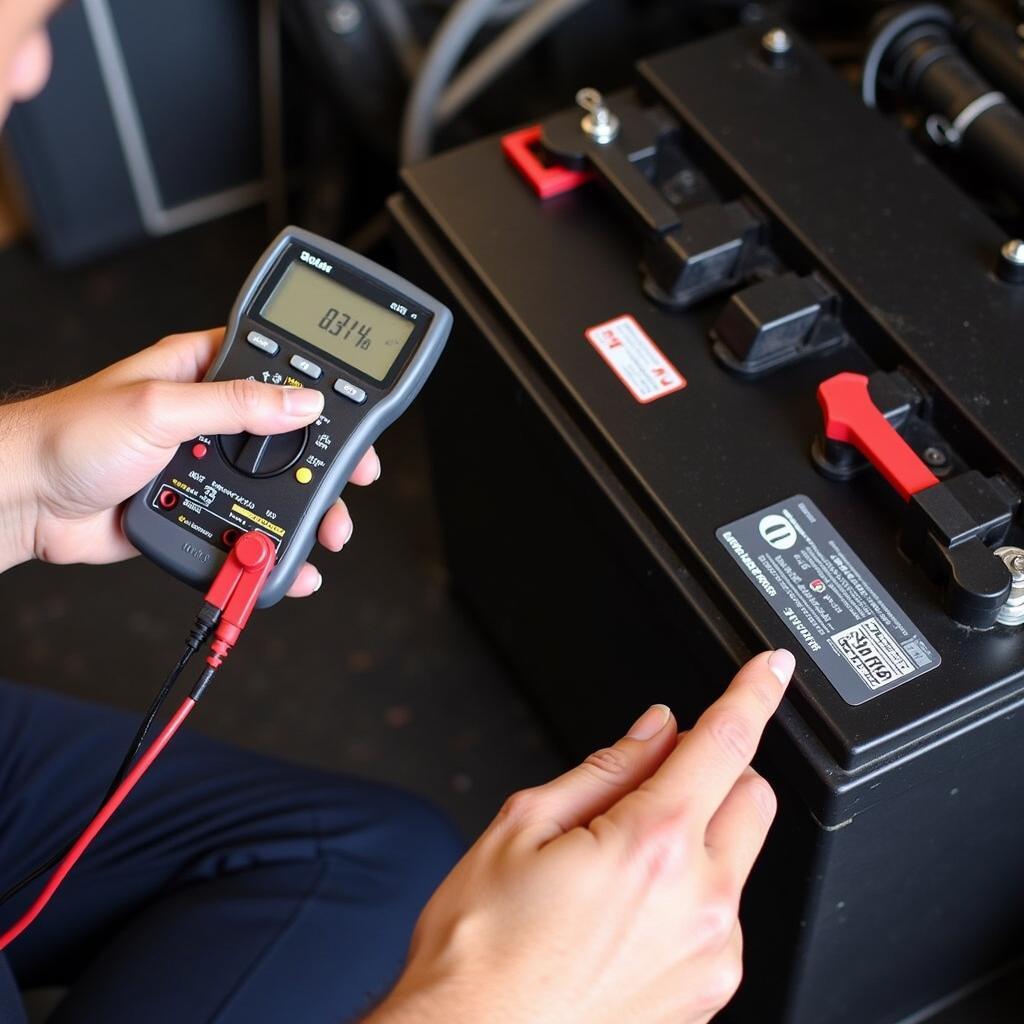What Does Checking Battery Terminal Service in Cars Mean?
Checking battery terminal service in cars essentially means inspecting and maintaining the connection points between your car battery and the vehicle’s electrical system. These connection points are crucial for starting your car and powering all its electrical components. Neglecting them can lead to starting problems, dimming lights, and even complete electrical failure. Learn more about how to service your car battery at how to service my car battery.
Why is Checking Battery Terminals Important?
Battery terminals, typically made of lead or lead alloy, are prone to corrosion due to exposure to moisture, temperature fluctuations, and battery acid fumes. This corrosion builds up as a white, powdery substance (often lead sulfate) that acts as an insulator, disrupting the flow of electricity. This can manifest in various ways, from a sluggish engine crank to a complete inability to start the vehicle. Regular inspection and cleaning of these terminals ensures a strong electrical connection, preventing potential issues and prolonging the life of your battery. Understanding what happens during your first car service can shed light on the importance of battery terminal checks. Check out what happens in first car service for more information.
How to Check and Clean Car Battery Terminals
Checking your car battery terminals is a straightforward process that can be done with a few simple tools.
- Safety First: Always wear safety glasses and gloves when working with car batteries. Disconnect the negative terminal first, followed by the positive terminal.
- Visual Inspection: Look for any signs of corrosion, cracks, or loose connections. A white, powdery substance around the terminals indicates corrosion buildup.
- Cleaning the Terminals: Use a wire brush or a dedicated battery terminal cleaner to remove corrosion. A mixture of baking soda and water can also be effective.
- Securing the Connections: After cleaning, ensure the terminals are tightly secured to the battery posts. Apply a thin layer of dielectric grease to prevent future corrosion.
- Reconnect the Terminals: Reconnect the positive terminal first, followed by the negative terminal.
 Car Battery Terminal Cleaning Process
Car Battery Terminal Cleaning Process
Signs of Bad Battery Terminals
Several signs indicate potential problems with your battery terminals:
- Difficulty starting the engine
- Dimming headlights or interior lights
- Clicking sound when turning the key
- Electrical malfunctions
- Corrosion buildup on terminals
Knowing what to check when servicing a car is essential for maintaining its optimal performance. Learn more at what to check when servicing a car.
What Does Battery Terminal Service Include in a Professional Car Service?
During a professional car service, a technician will typically inspect the battery terminals for corrosion, clean them if necessary, and ensure a tight connection. They may also test the battery’s voltage and overall health, ensuring it’s functioning correctly. Understanding what it means to get a car serviced can help you appreciate the comprehensive nature of this process. For a better understanding, visit what does it mean to get a car serviced.
 Mechanic Inspecting Car Battery Terminals
Mechanic Inspecting Car Battery Terminals
Preventing Battery Terminal Corrosion
Preventing battery terminal corrosion is crucial for maintaining a healthy car battery. Here are some preventative measures:
- Regularly clean the terminals with a wire brush and baking soda solution.
- Apply dielectric grease to the terminals after cleaning.
- Keep the battery terminals and surrounding area clean and dry.
- Ensure the battery is properly secured to prevent vibrations.
Expert Insights
“Checking battery terminals is often overlooked, but it’s a simple task that can prevent major headaches down the road,” says Robert Johnson, Lead Automotive Technician at Johnson’s Auto Repair. “A few minutes of maintenance can save you from a costly tow truck call.”
“Corrosion can significantly impact your car’s electrical system, leading to various issues, from starting problems to complete electrical failure,” adds Sarah Miller, Certified Automotive Engineer at Miller Automotive Solutions. “Regular inspection and cleaning of the terminals are crucial for maintaining optimal performance.”
 Applying Dielectric Grease to Battery Terminals
Applying Dielectric Grease to Battery Terminals
Conclusion
Checking battery terminal service in cars is a vital aspect of car maintenance that ensures a reliable electrical connection and prevents potential starting problems. Regular inspection and cleaning of the terminals, along with preventative measures like applying dielectric grease, can prolong the lifespan of your battery and keep your car running smoothly.
FAQ
- How often should I check my car battery terminals? It’s recommended to check your battery terminals every few months, or more frequently if you live in a harsh climate.
- Can I clean my battery terminals myself? Yes, cleaning battery terminals is a simple DIY task.
- What tools do I need to clean my battery terminals? You’ll need a wire brush, baking soda, water, and dielectric grease.
- What should I do if my car won’t start after cleaning the terminals? If your car still won’t start, the battery itself may be dead or there could be another underlying issue.
- How can I prevent battery terminal corrosion? Regular cleaning and applying dielectric grease are the best ways to prevent corrosion.
- What are the signs of a bad car battery? Difficulty starting, dimming lights, and a clicking sound when turning the key are all signs of a bad battery.
- How long do car batteries typically last? Car batteries typically last between 3 and 5 years.
Need Help?
For any assistance or further inquiries regarding car diagnostics and services, please don’t hesitate to contact us via WhatsApp: +1(641)206-8880, Email: [email protected] or visit our workshop at 456 Oak Avenue, Miami, FL 33101, USA. We offer 24/7 customer support.

